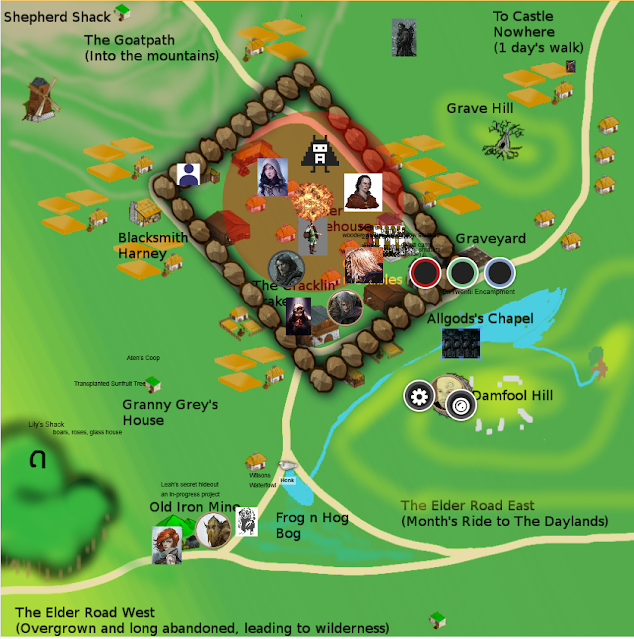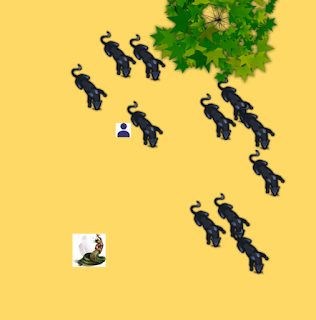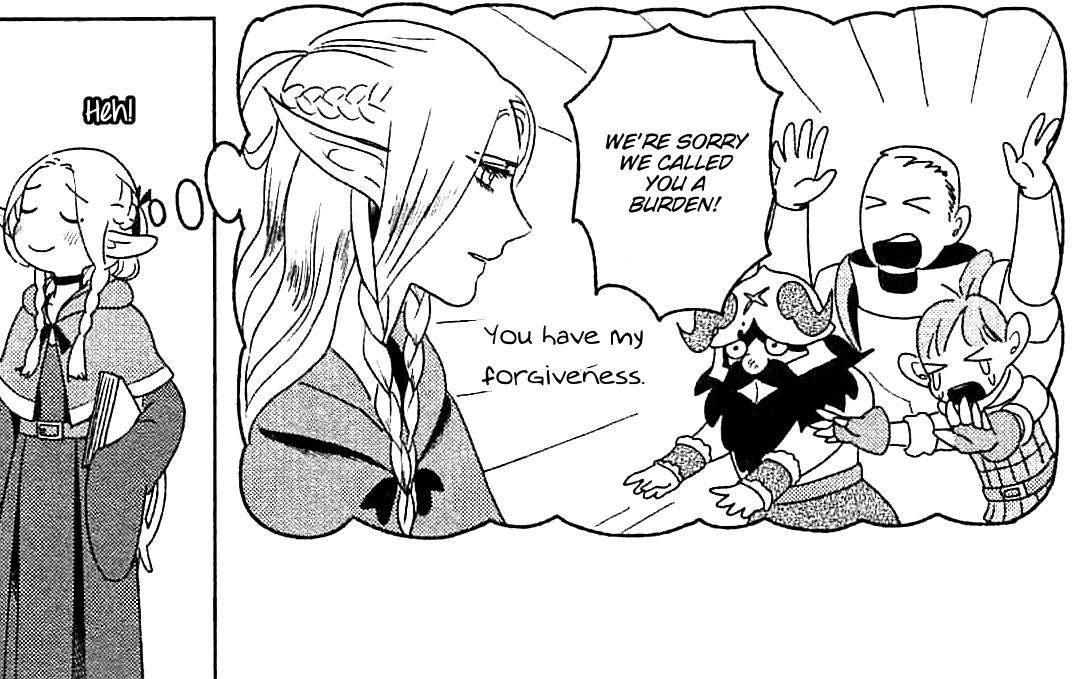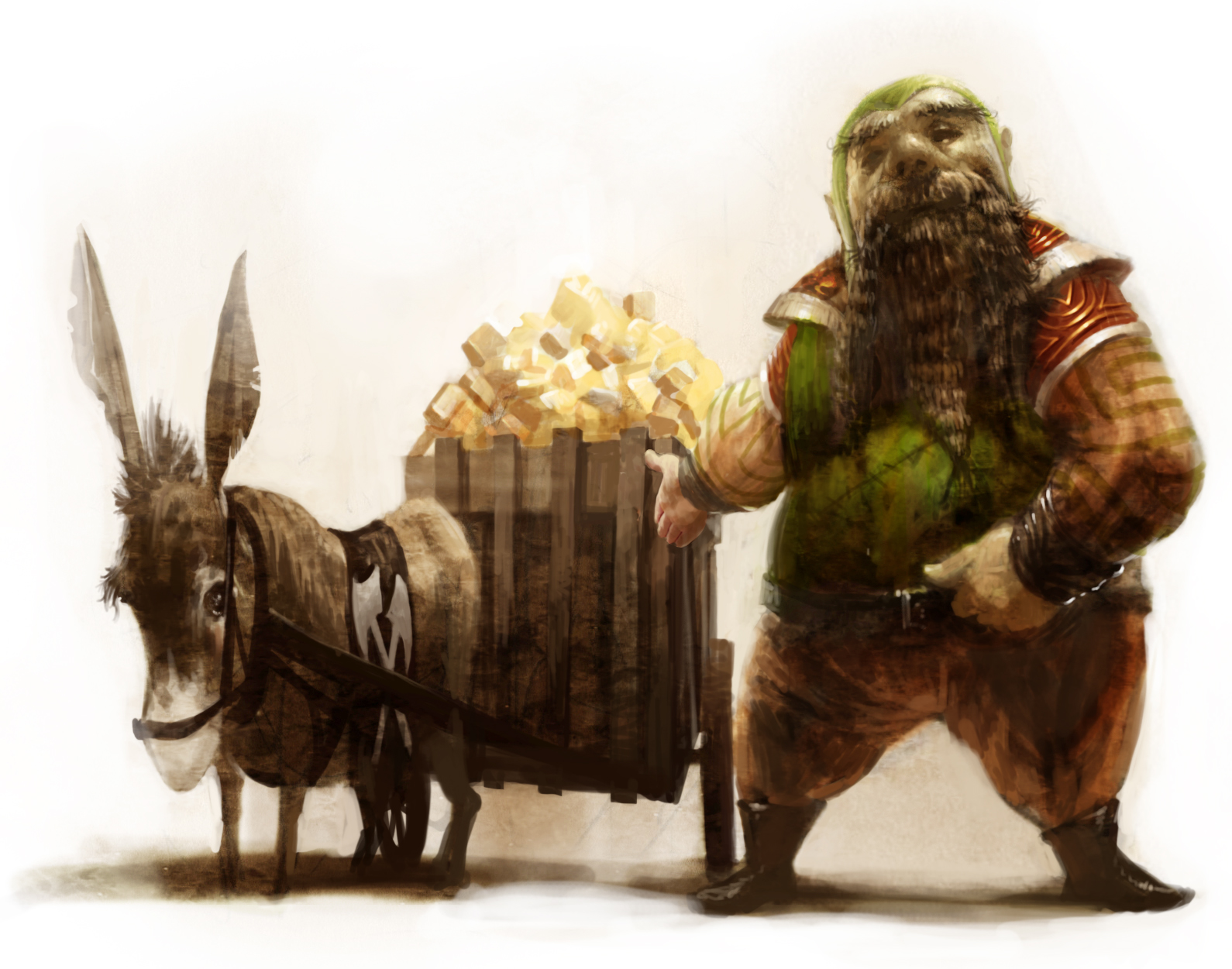Three years ago I made this moderately popular post about past campaign worlds, and I think it's about time I updated it with what I've run since then and perhaps what was learned.
CASTLE NOWHERE
After the politicking of Crownless Lands, I wanted to return to ye dungeoncrawling, and an individual sense of struggle and survival rather than faction jockeying. At this time I had been playing quite a bit of Enter the Gungeon and Darkest Dungeon and had belatedly gotten into the lore of Undertale, so I had a notion of looping time where each adventure would go through similar areas, with increasing familiarity allowing easy bypassing, knowledge of where the plate armor was to upgrade the frontliner, and so on. Additionally, death would be irrelevant, a time loop ensuring a way to keep characters constant but threat level high, even easier than even widespread Raise Dead. To keep the focus on individual treasures rather than gold hoards, I used a copper standard without changing rulebook prices. 1 copper piece was worth 1 xp, making lanterns and other mundane items valuable treasures, and a suit of plate stolen from Castle Noure's armory racks
Not much of this design sentiment survived the early drafts, as I think it would have required a singular carefully crafted megadungeon to work, but I did not have that sort of prep time available. So the focus of the campaign was a single small village beneath the eponymous Castle Noure
 |
| A quick view of the village map. Upgrading the village wasn't the focus of the game, but was a satisfying part |
With a very small hex map in case the players got cabin fever and wished to wander, though this campaign was set in the Moonlands, a place where the sun was a rare occurrence and the lights of alien moons warped reality and spawned monsters. It was no place for mortals to go wandering about narratively, and on the meta level, this was not a hex crawl campaign.
 |
With the dire outside established, the focus then turned to the accursed, time-looped estate which was composed of 3 modules- Ynn, Castle Gargantua, and Maze of the Blue Medusa, with Ynn as the ever-changing grounds of the estate that must be crossed, Castle Gargantua as filling for the towers and 'minidungeons' that might be found from entering buildings that were not Noure proper, and MotBM as the 'Final Area' within which were contained the secrets of the decadent nobles and mad experimentation that caused this loop. All were warped to suit the campaign setting rather than used as is, but Ynn was praised, MotBM disappointed, and Castle Gargantua was mostly ignored, but I feel like, with some tweaking, could be worth trying again.
Another sleeper hit was a tweaked version of the Meal of Oreshegaal, (which I still can't spell) which in my warped version had the Tuskmen as once-human peasants subjected to famine that Oresh turned to pig-people so that they could survive via cannibalism rather than become ghouls. As some of the more ghastly elements of the manor were removed, Oresh became everyone's favorite creepy wizard uncle and the party allied with him against the entity responsible for the time loop (which in a twist, was not a time loop at all, but a manual reset using clockwork machinery, cloning facilities, which then gave everyone a bit of an identity crisis upon the revelation that many of them were clones made to play out assigned roles).
Player attendance became wobbly near the end, but a final epic conclusion or three were achieved, and a combination of retirement and new recruitment was set out for the next portion of the campaign.
Things I learned from Castle Noure
1. Having the players be desperately poor is fun, but can wear thin in the long run- I am more likely to switch to 'barter only, coin isn't real' than go full on copper standard but silver/gold book prices again.
2. Making death a non-issue has mixed results depending on playgroup. Some players had more fun not having to worry about permadeath, and/or learned the value of permadeath by seeing the effects of hanging on to a character who had outstayed their welcome. While others used it as a crutch to support existing over investment and loss-aversion and were led astray, perhaps. I think future games of mine will have to pick a path, so to speak, either making death more menacing, or leaning harder into the 'fantasy soulpunk' idea I have for the setting, where death is just deportation to the netherworld and human consciousness in artificial bodies is the new transhumanism mood.
3. An absolutely hostile wilderness less fantasy wilds and more 'cosmic horror' is very fun, but again can wear thin in the long run. I am greatly amused by my veteran players who survived the Moonlands chuckling to each other when newbies ask about the Moonlands or naively assume that they couldn't be that bad out loud.
4. Reliable 'crafting systems' for potions and the like have a sort of appeal, but I think are doomed for a variety of reasons. Most importantly, I think potion ingredients must be confined to things that cannot be farmed safely, or you run the risk of having to run Magical Industrial Revolution with potions/magic items. Which could be fun if that's the premise of the game, but if it's just one player wanting to set up basilisk and mandrake factory farming, you probably get a pacing/tone/balance issue.
5. Having a premise to do 'one thing' in a campaign is great and good and has always been more successful than keeping things strictly 'get in ye dungeon and get rich and figure out what you REALLY want along the way". "Break the Curse of House Noure or Get Rich Trying" was the initial goal of the campaign, it fragmented into other goals, and finally, when the campaign was over, some characters retired, but some had formed a proper adventuring party forged from the unity of their common goal.
If there was a theme to the 54 sessions or so of Castle Noure, it was something about leaving past trauma behind and focusing on found friendships and family. But of course, it was not to last, for call no PC happy till they are safely retired offscreen...
IRON-CROWNED OROBORO
 |
| Map lacks some player added portions |
After the party finished with Castle Noure, their next goal was to take their 60-foot tall clockwork fighting robot and walk it out of the hellish moonlands to sanity and sunlit lands, for a variety of reasons. Thirbaek Merrymace, cleric of dead gods, had properly put one of his gods to rest, and now sought to find the sunshard fragments of Riikhus and reassemble him. Blix wanted to honor the wishes of some bugfolk and bury them on the isle of Ebetheron, and also go on a honeymoon with their protein polymorph gf. But mostly, people just wanted to keep playing and get out of the moonlands, and Oroboro was a part of the setting that was well-fleshed out due to the past Crownless Lands campaign, so it made for a good destination.
Oroboro was supposed to be a city crawl+megadungeon, and I had a vision for the megadungeon, with rooms that would fill and empty with seawater, making timing very important, and equipment more important yet, as armor protected from monsters, but not drowning. A hell of undead and fishy monstrosities, a corrupt sore at the heart of the city that had formed from the unfinished business of Oroboro.
Looming threats were the cult of Janus, cthonic demon god of blood and gold, their temple a crater filling with seawater, and the dread Ningen King, a giant merman made into immortal monster by the artifact Topaz, and his rivalry with King Samuel Goffnagoff, an old PC who had become king, as well as the machinations of the ancient serpent rulers of the city, a necromancer cult which outlived the loss of its head, a giant wasp-queen Happy who was raised by humans but whose offspring lacked morality and hungered for brains, and the neighboring country of Fassulia in a magical cold war with Oroboro.
The players were no mere murderhobos delving with rusty spoonshivs now, however- levels started at about 3-5, and reached 6-7. Waterbreathing and light were spells that trivialized some of the mundane threats of the dungeon, which was slightly disappointing, but the players found the place disgusting and dangerous enough that they probably would not have been willing to delve it without these magical tools. A fine balance is required to make dungeon delving at higher levels still feel dangerous, and I think it was barely met here, but, especially once teleportation and flight became available, it surely felt like the players were outgrowing many of the problemsolving parts of dungeon delving.
However, their heightened power, especially mobility-wise opened them up to the wonders of hexcrawling and domain building, and I soon found myself in need of prep far beyond the Sepulchre.
 |
Apologies for that doozy of a runon, have an image of Blix, Erhard, and Thierbaek, as well as retainers Serenity the hatecubus/Erhard's Sword, and Kitadatapa, moral compass spider cleric.

Samuel was petrified and overthrown, which led to what would later be known as the Oroboron Civil War, in which some supported the legitimate claim of the Serpent Queens, while others supported the human Goffnagoff family who refused political marriage and opted for revolt (Princess Evalyn being the Rebel leader). I rolled reactions amongst Samuel's knights to see who would join the rising serpent queen and who would rebel, and was surprised to see that most rebelled (save for the most mercenary of them). More surprising still was the split of player loyalty to different sides of the civil war. Each side was largely identical in politics, so it really was down to character moments- Some valued their feudal oaths to the knights, or had sinister mirror-cult conspiracies at play, or simply sided with their best friends or just were double-agent lesbians
 |
| hey, a motive's a motive |
Anyway, each side was given private channels to communicate in, and they plotted and schemed, drawing allies from local factions they met in more standard play to aid them, employed counter-measures and counter-countermeasures via spying and double agents and intelligence work, and I as GM was just the neutral arbiter of all this. Though some people felt betrayed, for the most part this was very enjoyable to everyone, as playing against other players with GM as arbiter lead to lots of problem solving. In the end people died, players retired, and the Serpent Queens were cast into prison or the pocket dimension from which they came (or beheaded by KAN for inscrutable purposes), the Lumarian conspiracy was revealed and [REDACTED] (he sold his name to a bugbear) the Mirror-Pope fled to the mirror realm, and the party's ties were now shooketh and everyone resolved to sail away from this political squabbling on a boat to become pirates instead.
What did I learn from this 65 session campaign? Well, one thing was what D&D in the 5-7 range really starts to look like. I would not go so far as to say this was 'true' domain play as we did not get deep into the nitty gritty of how many pikemen can guard a 5' wide breach in a player-build castle wall, there were mercenary troops hired, there were night raids on war camps, there was A player castle built on the ruins of the reclaimed Hill Giant Steading, there were religious conspiracies and marriage angles, it was all pretty great. With regards to 'domain play' I think there needs to be a goal- idly upgrading and sleeping at Fort Fortenfort (said player castle) was briefly fun, then ignored, but the goal of the Civil War galvanized players into 'domain level' actions. The trick might be setting- you need it to be wilderness enough that the players have room to grow, but also have nearby factions of all types so the players aren't just clearing hexes of direwolves or whatever.
According to one player, the theme of this campaign was 'Loyalty' not just to fellow party members and maximising loot, but to ideological goals. While fun, the Civil War took a lot out of people and they resolved to go on a piratical boat adventure with no complicated politics, just a desire to escape Oroboron politics and stop a prophesy that said the fled wasp-princess might bring about the end of the world via domination of brain-eating wasps.
VOYAGE OF THE THIEFBOAT
Things seemed to start off well- the party scrying the wasp-princess, robbing a tower of an archmage of its goodies (even learning the Wish spell, albeit a Glogified one), dealing with plague rats on the ship and pressganging pirates into joining. Then came Cycladea, a Lungfungus created island module meant to emulate bronze-age greek mythology.
 |
| In and out, talk to the wasp-princess out of causing the apocalypse, and definitely don't get caught up in Iliad/Gigantomachia shenanigans, 20 minute adventure |
Bouncing around Cycladea started low-impact, looting some dungeons, helping villagers, meeting wizards. But these were not fresh characters. They had strings on them. Arsem's madness and Firstborn(the forsaken homunculous 'daughter' of Blix)'s pact with the Great Raven led them to piss off a terrible wizard who was cursed by the gods after their initial friendly meeting. Animated skeletons (and covert vampires who snuck on in Oroboro) caused a mutiny on the ship, and Finzu, the Pyromancer, lit a city aflame with everburning fire with some magical shenanigans. The party sided with the king who had imperialist dreams, and vowed to defeat the goddesses of Cycladea who were admittedly jerks in the greek pantheon way. The temples of the goddesses were burnt and pillaged, the kings forced to bow. Those of the party who enjoyed the chaos revelled, those with morals left the boat behind, Kithri the halfling slipping off to garden and raise sabre-toothed tigers elsewhere, Firstborn teleporting back to Fassulia to atone and work on the side of law, mourning the lost friendships the Civil War had ruined, Thirbaek and his wife the High Incarceratrix used a sunshard and miracles to have a vampire-dwarf-sunchild and started a new pantheon and went on to rule Stonefast 2 in other lands, Grift died and joined said pantheon as a new incarnation of Kispiritis, and so on. The islands fought back, but frankly, Lungfungus's world was not meant to deal with level 7-8 adventurers with a wide variety of spells and multiple spellcasting systems, especially when supported by arguably the most powerful faction there.
However, the victory-drunk party did not heed the hint that they may be succumbing to hubris when the previously pissed off wizard got a good lightning bolt off, and did not correlate characters leaving them to their capabilities weakening. After the final temple was burned and the Cyclops were freed, they sailed to the forbidden Isle of the gods, slapped around some fantasy creatures, then picked a fight with 13 lions lazing under a tree.
After round 3 arrived and half the party was dead,
 |
| This is how a high (for OSR) level campaign ends- hubris, and cats |
The survivors retrieved a teleport scroll from a corpse, and tried to teleport out. The teleport landed on the 100 result, the dreaded 1% chance to teleport yourself into rock and die (though we left it open to interpretation that they ended up in the Veins or another plane of existence) and so ended the campaign, on a wild but somewhat anticlimactic note Those players who had quit while they were ahead got happy endings at least.
I was gladdened to hear feedback that the 22 sessions of Thiefboat were satisfying to players though. It was not a glorious story, it was a tragedy of the corruption of power, hubris, and how fractures in interpersonal relationships go deep. What did I learn from Thiefboat?
1. High level play is strange, with its teleportations and flight and so on. Verisimilitude-wise, GMs must think of how cities and rival wizards will defend themselves from obscure methods of attack like, say, 2000-foot long dragon turtle shells being dropped from the sky, or magical arson. But things are still dangerous, and reliance on the big obvious tools can leave the players blind to the fact that they have 23 HP and that can go away from 3 dudes with arrows in one round.
2. Boat travel can be hard to make interesting without succumbing to the temptation of shipwrecks and krakens. One of the more interesting things was the homicidal Captain Arsem secretly engineering a mutiny as an excuse to kill the 3 crew his madness demanded die to save the future from the prophecy, only to have that mutiny coopted by the vampires who had snuck aboard a while ago. While that's a rather extreme example, social scenes with people on a boat have a lot of potential, as can problems like 'how to get rid of plague rats' or 'find out who is drinking all the rum' or 'secure limes' and so on.
3. Player attrition, especially on open tables, may be inevitable as the scope of campaigns shift away from what originally drew them. Part of why Castle Nowhere/Oroboro/Thiefboat lasted as long as it did was thanks to player recruitment persisting so even when some players had to leave, there were usually some waiting to take their place.
Anyway, player numbers had dropped from 'open table' to more 'single party of regulars' by the end of thiefboat, so it was time to move on, and time to do something a little different (no no, we aren't at Lancer yet)
BETRAYAL AT QUEENS COAST
 |
| Whimsical castle Daotengard, overtaken by demon-frogs and a contagious froggification curse |
Anyway! I learned a few things here
1.Turning social scenes into more gamified spaces (I had a 'Dance Pentagon' where entering exposed you to various NPCs who could help or hinder you, attacking HP intentionally or unintentionally via mean words or simple dance exertion, but you had to do it to get private conversations) can help to make them feel like they have timing and stakes compared to just 'you talk at NPCs for 12 hours.' Just roleplaying via chat is fine too of course, but I think making weird social games based on positioning and resource management (spare dresses if wine is spilled on you!) is better than making them about rolling a skill check for Diplomacy or what have you.
2. Similar to wolf moons, this was a bloated disaster of houserules... having received the DCC RPG book as a gift from a player, I eagerly sought to add it to the game... on top of GLOG casting... on top of all my other houserules to BFRPG... on top of a mixed level up system using both BFRPG GP=XP and Die Trying X's and DCC's model... suffice it to say that this abominable frankenhack would have been better served by leaping into the nearest dumpsterfire and leaving us to play Fate or PbtA or a proper story game. We squeezed great roleplay and schemes despite the system, and used the system for a few janky heists and dungeon delving for coin, but it was really a ball-and-chain, especially the XP thing. We survived 22 sessions under its yoke, but I could feel my bloated house-rules coming apart at the scenes as it barely supported the story-game mode of play on it.
coins to XP is an elegant system IF you stick to the prescribed purpose of dungeons and dragons as a dungeon delver. This campaign departed far from those goals, but really made me think of the limitations I was working under. In short, I needed an OSR break to ponder what to do rules-wise upon my return. I dread subjecting players to a homebrew rulebook after the disasters of Wolf Moons's Nightmare Glog, but I think I have reached the point where 'BFRPG with houserules' is something I can only run if I return to very bare-bones 'delve the megadungeon!' campaigns, and even if I do that, I need to make a definititive houserules/setting primer document.
Anyway, I'm running and playing in Lancer games at the moment, and we'll see how long that phase lasts, and if I return to OSR immediately, or if my 'break' continues to run some storygames. However, even Lancer takes place in the same setting (after a fashion) so I hope to continue stacking layer upon layer of lore regardless of what the system is.
No proofreading, only post










